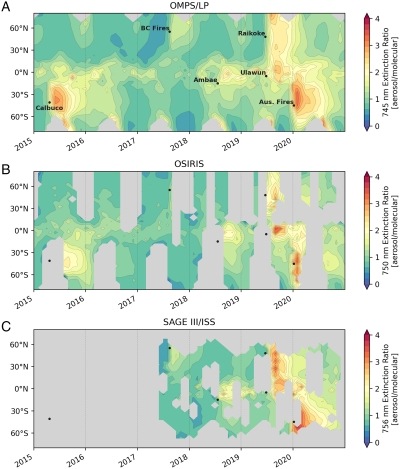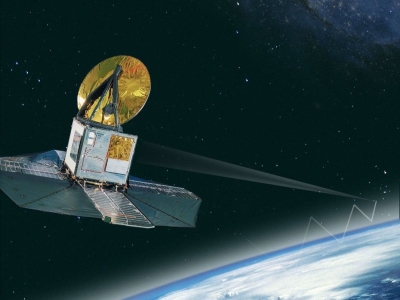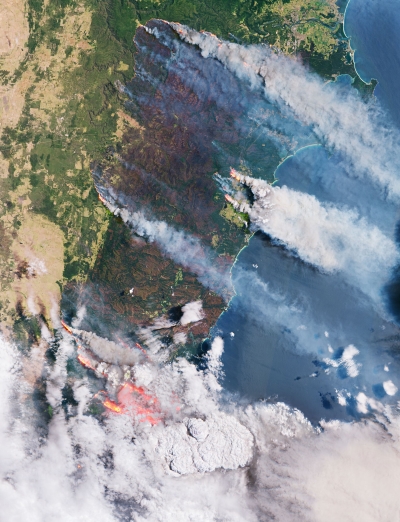- News
- Atmosphere-studying Odin missi...
Atmosphere-studying Odin mission enjoys ongoing success
16 Dec 2022
More than two decades after it began operations, the Odin remote sensing satellite is continuing to make strong contributions to high-impact atmospheric science.

Over the past year Odin has delivered numerous achievements – including tracking the impacts of wildfires and volcanic eruptions on the ozone layer – and the mission is set to carry on into 2023 and beyond.
This sustained success was highlighted at a recent gathering convened by the science team that oversees the satellite.
Launched in 2001, the mission’s development was led by the Swedish National Space Agency in collaboration with its partner agencies in Canada, Finland and France.
Odin was designed to investigate both the formation of the early Solar System and the processes taking place in Earth’s atmosphere, such as ozone depletion and the impacts of climate change. The mission now concentrates on the latter application.
The satellite is part of ESA’s Third Party Missions programme, which disseminates its data to users for free, for research purposes. As part of this agreement, ESA is supporting the satellite’s operations.
Outstripping Expectations

Its two instruments – the Submillimeter Wave Radiometer (SMR) and Optical Spectrograph and Infrared Imaging System (OSIRIS) – work together to measure atmospheric composition.
The mission has far exceeded its initial planned lifespan of two years, and both of these sensors continued to deliver high-quality data in 2022.
- SMR – which is a passive microwave limb sounder – detects molecular transitions of aeronomical interest.
- OSIRIS – a dual-purpose ultraviolet, visible and infrared limb sounder – detects aerosol layers and retrieves altitude profiles of terrestrial atmospheric chemical species, such as ozone, nitrogen dioxide, and sulphur dioxide.
The teams responsible for the information delivered by both instruments are furthering their efforts to process these data into products, which are used by scientists and researchers to investigate different aspects of the atmosphere.
High-impact Science
In science published this year, researchers drew on data from Odin’s OSIRIS sensor and other atmosphere-monitoring missions to investigate the atmospheric impacts of the wildfires that gripped Australia in 2019 and 2020.
The scientists investigated whether plumes of smoke released by large wildfires impact the layer of stratospheric ozone that blankets the planet.
The team observed that wildfire aerosols resulted in a sharp drop in nitrogen dioxide in the stratosphere, which is the first step in a chemical cascade that is known to end in depletion of the ozone layer.

This finding suggests that the increasing frequency and intensity of wildfires brought about by climate change could impede recovery of the ozone layer, at least sporadically.
Another research project – which is currently being completed – focuses on the eruption of the Hunga Tonga submarine volcano in the Pacific in early 2022.
Aerosols released by volcanoes affect the ozone layer by providing a surface on which chemical reactions take place and, as part of the research, scientists are using OSIRIS data to explore the extent to which the Hunga Tonga eruption contributed to the depletion of stratospheric ozone.
In addition, OSIRIS data is contributing to global assessments of ozone delivered by the World Meteorological Organisation, which help direct international efforts to promote the recovery of stratospheric ozone.
Odin’s SMR sensor is also enabling cutting-edge scientific research.
These data have been used to quantify the amount of nitric oxide induced by energetic particle precipitation descending every winter as part of the polar vortex from the upper mesosphere and lower thermosphere to lower altitudes, where it can contribute to ozone depletion.
As fluxes of energetic particles are related to solar activity, a better understanding of these processes is essential to delivering new and improved insights into Sun-Earth interactions.
A further study investigating the effect of atmospheric tides on nitric oxide is currently being completed.
After the meeting, Kristell Pérot, a key member of the Odin science team and head of Earth observation research at the Swedish National Space Agency, concluded, “Even after almost 22 years in orbit, Odin continues to lead high impact science, and it still has several years to go!”